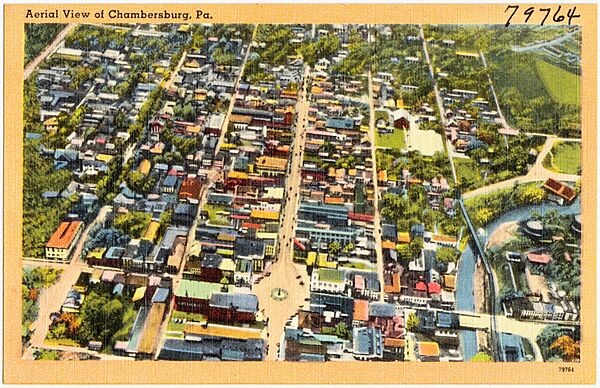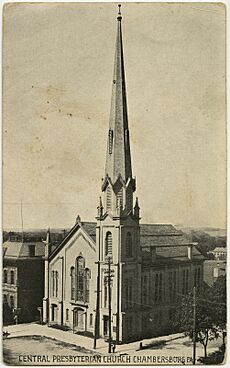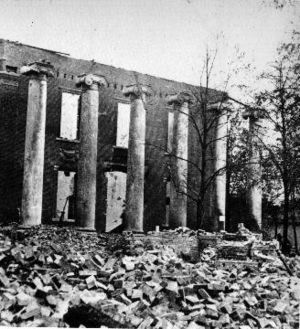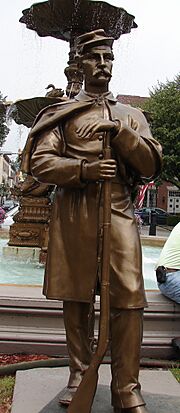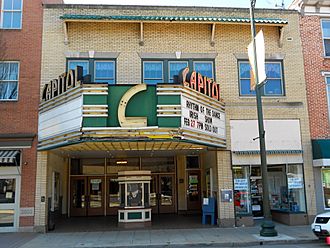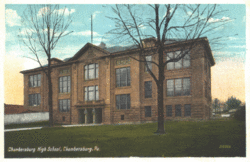Chambersburg, Pennsylvania facts for kids
Quick facts for kids
Chambersburg, Pennsylvania
|
|||
|---|---|---|---|
|
Borough
|
|||
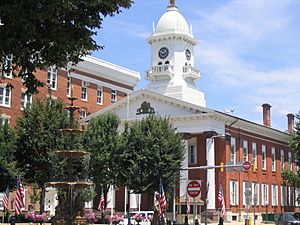
Memorial Square in downtown Chambersburg
|
|||
|
|||
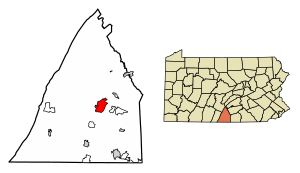
Location within Franklin County and Pennsylvania
|
|||
| Country | United States | ||
| State | Pennsylvania | ||
| County | Franklin | ||
| Founded | 1734 | ||
| Incorporated | 1803 | ||
| Named for | Benjamin Chambers | ||
| Area | |||
| • Borough | 6.92 sq mi (17.94 km2) | ||
| • Land | 6.92 sq mi (17.94 km2) | ||
| • Water | 0.00 sq mi (0.00 km2) | ||
| Elevation | 640 ft (200 m) | ||
| Population
(2020)
|
|||
| • Borough | 21,903 | ||
| • Density | 3,165.2/sq mi (1,220.9/km2) | ||
| • Urban | 52,273 | ||
| • Metro | 149,618 (Micropolitan area) | ||
| Time zone | UTC−5 (EST) | ||
| • Summer (DST) | UTC−4 (EDT) | ||
| ZIP Code |
17201, 17202
|
||
| Area code | 717 and 223 | ||
| FIPS code | 42-12536 | ||
| GNIS ID | 1215243 | ||
| Website | Official website: http://www.borough.chambersburg.pa.us/ | ||
Chambersburg is a town, also called a borough, in Franklin County, Pennsylvania. It's the main town, or county seat, of the county. Chambersburg is located in the south-central part of Pennsylvania, in a wide valley called the Cumberland Valley. This valley is part of the larger Great Appalachian Valley. The town is about 13 miles (21 km) north of the Maryland border and 52 miles (84 km) southwest of Harrisburg, the state capital.
In 2020, about 21,903 people lived in Chambersburg. If you include the nearby areas, the population of Greater Chambersburg is around 52,273 people. The town is known for its history, especially during the American Civil War. It was the only major town in the northern states that was burned down by Confederate soldiers during the war.
Chambersburg is a busy transportation hub. Major roads like the Lincoln Highway (U.S. 30) and U.S. 11 pass through it. Interstate 81 is also very close. This makes Chambersburg an important stop between big cities like Pittsburgh and Philadelphia. The town often hosts fun events like a Food Truck Festival and Apple Fest.
Contents
Discovering Chambersburg's Past
Early European Settlement
The area where Chambersburg now stands was once home to Native American tribes. These included the Iroquois, Lenape, and Shawnee people. They used a route through the Cumberland Valley for trade and travel.
A Scots-Irish immigrant named Benjamin Chambers is believed to have started the settlement in 1730. He built mills powered by the water from Falling Spring Creek and Conococheague Creek. The settlement grew around these mills and was first known as "Falling Spring."
In 1734, Benjamin Chambers got permission to own 400 acres (160 ha) of land. However, owning land here was tricky until 1763. This was because not all Native American tribes had agreed to sell their land to the British.
The Penn family, who owned Pennsylvania, wanted more people to settle here. This helped them in a land dispute with the Maryland Colony. Benjamin Chambers even traveled to England to support the Penn family's claims.
The area was first part of Chester County, then Lancaster County, and later Cumberland County. Finally, Franklin County was created in 1784, with Chambersburg as its main town.
Roads, Forts, and Early Life
An important route called the Great Wagon Road passed nearby. It connected Philadelphia with the Shenandoah Valley. By 1744, this road went through Chambersburg. In 1748, a local group of armed citizens was formed to protect against Native American attacks. Benjamin Chambers became their leader.
During the French and Indian War, Chambersburg was still a frontier area. Benjamin Chambers built a private stone fort with two cannons to protect the settlement. Many settlers left during the war, but most returned after 1764.
Another important road, the Forbes Road, also passed near Chambersburg. This road later became part of U.S. 30, connecting Pittsburgh and Philadelphia. Chambersburg became a key trading and transportation center where these major roads met.
The town of Chambersburg was officially planned out in 1764. Land lots were advertised for sale that summer.
The first settlers were mostly Scots-Irish Presbyterians, followed by German Protestants. Black people also lived in Chambersburg from the beginning. Benjamin Chambers owned a black female slave before the French and Indian War. By 1786, twenty enslaved people were recorded as taxable property.
The first church was started by Scots-Irish Presbyterians in 1734. Benjamin Chambers gave them land for a small yearly rent of just one rose. Two other churches, the First Lutheran Church and Zion Reformed Church, also got land this way in 1780. They are known as the "Rose Rent Churches." A Catholic community formed in 1785. St. James African Methodist Episcopal Church started in 1811, and the Mt. Moriah First African Baptist Church began in 1887. The Jewish cemetery dates back to 1840.
From Revolution to Railroads
In 1775, local troops from Chambersburg joined the fight against the British in the American Revolution. These soldiers, led by Benjamin Chambers's son, Captain James Chambers, were among the first non-New Englanders to join the fight. James Chambers served for seven years and became a Colonel. He fought in many important battles, including Long Island, Trenton, and Brandywine.
During the Whiskey Rebellion in 1794, some local citizens supported the rebels. However, they quickly changed their minds after a town meeting. President George Washington himself passed through Chambersburg while leading troops to stop the rebellion. This was one of only two times a sitting U.S. president personally led the military in the field.
Chambersburg officially became a borough in 1803 and was named the county seat. The first courthouse was built in 1793, and the first county jail in 1795. The "Old Jail," built in 1818, survived the fire of 1864. It was used as a jail until 1971 and is now a museum.
The town grew a lot because of its role in transportation. The U.S. Congress made Chambersburg part of the Philadelphia-Pittsburgh postal road in 1803. The Cumberland Valley Railroad arrived in 1837, making Chambersburg a major economic center for nearly 100 years. Before 1857, the fastest way to travel from Pittsburgh to Philadelphia was by stagecoach to Chambersburg, then by train.
Chambersburg and the Civil War
A Stop on the Underground Railroad
By 1859, Chambersburg was an important stop on the Underground Railroad. This was a secret network that helped enslaved people escape to freedom. Many free and enslaved Black people, along with white allies, lived here. Several schools in Chambersburg taught Black children, which was against the law in southern slave states.
John Brown, an abolitionist who fought against slavery, stayed in Chambersburg in 1859. He was planning his famous raid on Harpers Ferry. He pretended to be an iron mine developer and stored weapons disguised as mining equipment. Brown even met with famous abolitionist Frederick Douglass near Chambersburg to discuss his plans.
Confederate Raids and the Burning of Chambersburg
During the American Civil War, Chambersburg was attacked three times by Confederate forces.
- In October 1862, Confederate Maj. Gen. J.E.B. Stuart raided the town. His cavalry destroyed railroad property, took guns and horses, and captured some Black men and boys.
- In June 1863, during the Gettysburg Campaign, Confederate troops occupied the town again. They burned warehouses and railroad buildings. General Robert E. Lee even set up his headquarters nearby.
The most devastating attack happened on July 30, 1864. Confederate Brig. Gen. John McCausland demanded a large sum of money from the town. When the town couldn't pay, a large part of Chambersburg was burned down. Most buildings were destroyed, except for a few like the Masonic Temple. This burning was ordered by Confederate Lieut. Gen. Jubal Early as revenge for Union forces burning homes in the Shenandoah Valley. No citizens lost their lives in the fire.
Rebuilding and Remembering
After the Civil War, Chambersburg was rebuilt with help from the state and private donations. It took over 30 years for the town to fully recover. Chambersburg also became home to one of the schools for children orphaned by the war. This school, later known as "The Scotland School for Veterans Children," educated over 10,000 children before closing in 2010.
The Civil War is a big part of Chambersburg's identity. In 1878, a Memorial Fountain was dedicated in the town center to honor Civil War soldiers and others who fought in wars. A statue of a Union soldier stands next to it, facing south as if guarding the town. Yearly events are still held to remember the burning of Chambersburg.
Historic Places to See
Many places in Chambersburg are listed on the National Register of Historic Places. This means they are important historical sites. Some of these include:
- John Brown House: Where John Brown stayed while planning his raid.
- Franklin County Courthouse: The main court building.
- Franklin County Jail: The old jail, now a museum.
- Masonic Temple: One of the few buildings that survived the 1864 fire.
- Memorial Fountain and Statue: Honors Civil War soldiers.
- Wilson College: A historic college campus.
- Zion Reformed Church: One of the "Rose Rent Churches."
Chambersburg's Location and Weather
Chambersburg covers about 6.8 square miles (17.6 km2) of land. It's located in the Cumberland Valley, near the Appalachian Mountains. The town is close to Caledonia State Park, a large park with hiking trails, including a part of the Appalachian Trail. Michaux State Forest, an even larger forest, is also nearby. Both offer great places for outdoor activities like fishing, hunting, and hiking.
The Conococheague Creek, known for its trout, flows through the middle of town. This creek eventually flows into the Potomac River.
Chambersburg has a climate with distinct seasons. Winters are cold, with average January lows around 23°F (-5°C). Summers are warm, with average July highs around 85°F (29°C). The area gets about 38 to 42 inches (965 to 1067 mm) of rain each year.
People and Jobs in Chambersburg
| Historical population | |||
|---|---|---|---|
| Census | Pop. | %± | |
| 1810 | 1,304 | — | |
| 1820 | 1,717 | 31.7% | |
| 1830 | 2,783 | 62.1% | |
| 1840 | 3,239 | 16.4% | |
| 1850 | 3,335 | 3.0% | |
| 1860 | 5,255 | 57.6% | |
| 1870 | 6,308 | 20.0% | |
| 1880 | 6,877 | 9.0% | |
| 1890 | 7,863 | 14.3% | |
| 1900 | 8,864 | 12.7% | |
| 1910 | 11,800 | 33.1% | |
| 1920 | 13,171 | 11.6% | |
| 1930 | 13,788 | 4.7% | |
| 1940 | 14,852 | 7.7% | |
| 1950 | 17,212 | 15.9% | |
| 1960 | 17,670 | 2.7% | |
| 1970 | 17,315 | −2.0% | |
| 1980 | 16,174 | −6.6% | |
| 1990 | 16,647 | 2.9% | |
| 2000 | 17,862 | 7.3% | |
| 2010 | 20,268 | 13.5% | |
| 2020 | 21,903 | 8.1% | |
| U.S. Decennial Census | |||
In 2000, there were 17,862 people living in Chambersburg. About 20.8% of the population was under 18 years old. The median age was 40 years.
What Drives Chambersburg's Economy?
The area around Chambersburg has a large farming community, including many Amish and Mennonite families. Farmers in Franklin County grow a lot of corn, wheat, and barley.
Chambersburg also has manufacturing businesses that make machinery, metal products, and process food. The biggest employers include healthcare services, the school district, and manufacturing companies.
Since 2006, the retail shopping scene in Chambersburg has grown a lot, with new stores and restaurants opening near Interstate 81.
Because Chambersburg is located on Interstate 81, it's a good spot for trucking and distribution companies. It's less than 100 miles (160 km) from Washington, D.C., and Baltimore, Maryland. The Letterkenny Army Depot, a military facility, is also a major employer just north of town.
Culture and Fun in Chambersburg
Chambersburg is a classic "small town" in America. People enjoy hunting, sports events like baseball games at Henninger Field, and high school football. The town even has its own professional football team, the Chambersburg Cardinals.
The Capitol Theatre opened as a movie theater in 1927. Today, it's a performing arts center that hosts plays, ballets, and concerts.
Wilson College is home to the Cumberland Valley School of Music. This school offers music lessons, classes, workshops, and summer camps. They also have a children's chorus and community bands.
Learning in Chambersburg
Wilson College
Wilson College is a private college founded in 1869. It was originally a women's college but started admitting male students in 2013. The college is known for its programs in Veterinary Medical Technology and Equestrian studies. In 2009, it opened an environmentally friendly building for its science and technology departments.
Public Schools in the Area
The Chambersburg Area Senior High School (CASHS) serves about 2,400 students in grades 9-12. It includes students from Chambersburg and nearby townships.
There are also two middle schools for grades 6-8: J. Frank Faust Middle School (CAMS NORTH) and Chambersburg Area Middle School SOUTH (CAMS SOUTH). CAMS was recognized with a "Blue Ribbon School" award in 2001-02, which is a high honor for American schools.
The Franklin County Career and Technology Center (FCCTC) is in Chambersburg. It helps students and adults learn vocational trades like plumbing or welding. Students from six different school districts attend FCCTC.
The Chambersburg school district has seventeen elementary schools. Many are being updated or rebuilt to meet modern needs.
Scotland School for Veterans' Children
The Scotland School for Veterans' Children (SSVC) was a special state-owned school. It offered free education and housing for children of Pennsylvania veterans. It started in 1863 as one of many "Soldier's Orphan Schools" for children whose parents died in the Civil War. Over time, it became the only one left and changed its name. It educated over 10,000 students before it closed in 2009.
Private Schools and Library
Chambersburg has several private schools, including:
- Corpus Christi (Catholic school)
- Cumberland Valley Christian School (Christian academy)
- Montessori Academy of Chambersburg (non-religious)
- Shalom Christian Academy (Mennonite affiliation)
The Coyle Free Library has been around since 1891. It started as a small collection of books and grew with donations. Today, it's part of the Franklin County Library system and is located in a building that used to be a post office.
News and Media
The Chambersburg Public Opinion is the local daily newspaper. It was founded in 1869.
For television, Chambersburg is part of the Harrisburg-Lancaster-York market. You can also get TV stations from nearby Hagerstown, Maryland. Chambersburg shares a radio market with Waynesboro, Pennsylvania, and Hagerstown, Maryland.
Sister City
Chambersburg has a "sister city" relationship with Gotemba, in Shizuoka, Japan. This means the two towns share cultural ties and learn from each other.
Famous People from Chambersburg
Many notable people have connections to Chambersburg, including:
- Martin Delany: An important abolitionist and the first African-American field officer in the U.S. Army.
- Gwen Ifill: A well-known journalist and author.
- Lil Skies: A popular Hip Hop artist.
- Alexander McClure: A famous editor and politician.
- Jean Stapleton: An actress known for playing Edith Bunker on All in the Family.
- Joseph Winters: An African-American inventor and abolitionist.
Images for kids
See also
 In Spanish: Chambersburg para niños
In Spanish: Chambersburg para niños




